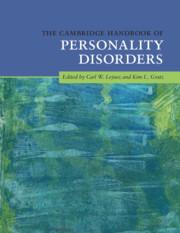Book contents
- The Cambridge Handbook of Personality Disorders
- The Cambridge Handbook of Personality Disorders
- Copyright page
- Contents
- Figures
- Tables
- Contributors
- Preface
- Part I Etiology
- 1 Neuroimaging in Personality Disorders
- 1a A Clinically Relevant Neuroscience for Personality Disorders: Commentary on Neuroimaging in Personality Disorders
- 1b Methodological Advancements Needed in Neuroimaging Research on Personality Disorders: Commentary on Neuroimaging in Personality Disorders
- 1c Illustrating the Value of Neuroimaging Studies Using the Example of Affect Regulation: Author Rejoinder to Commentaries on Neuroimaging in Personality Disorders
- 2 Issues and New Directions in Personality Disorder Genetics
- 2a Four Key Areas for Further Investigation: Commentary on Issues and New Directions in Personality Disorder Genetics
- 2b Highlighting the Value of Dimensional Conceptualizations and Environmental Influences: Commentary on Issues and New Directions in Personality Disorder Genetics
- 2c Questioning Current Directions in Personality Disorder Genetics: Author Rejoinder to Commentaries on Issues and New Directions in Personality Disorder Genetics
- 3 Environmental and Sociocultural Influences on Personality Disorders
- 3a Evidence for Caregiver Factors Proposed by Attachment and Biosocial Theories in the Development of Personality Disorders: Commentary on Environmental and Sociocultural Influences on Personality Disorders
- 3b Towards a Family Process Perspective on Typical and Maladaptive Personality Characteristics: Commentary on Environmental and Sociocultural Influences on Personality Disorders
- 3c Moving Contextual Personality Research Forward: Author Rejoinder to Commentaries on Environmental and Sociocultural Influences on Personality Disorders
- 4 Personality Pathology in Youth
- 4a Toward the Integration of Developmental Psychopathology and Personality Pathology Perspectives: Commentary on Personality Pathology in Youth
- 4b A Developmental Psychopathology Perspective on the Emergence of Antisocial and Borderline Personality Pathologies across the Lifespan: Commentary on Personality Pathology in Youth
- 4c Bridging Diverging Perspectives: Author Rejoinder to Commentaries on Personality Pathology in Youth
- Part II Models
- Part III Individual Disorders and Clusters
- Part IV Assessment
- Part V Treatment
- Index
- References
2 - Issues and New Directions in Personality Disorder Genetics
from Part I - Etiology
Published online by Cambridge University Press: 24 February 2020
- The Cambridge Handbook of Personality Disorders
- The Cambridge Handbook of Personality Disorders
- Copyright page
- Contents
- Figures
- Tables
- Contributors
- Preface
- Part I Etiology
- 1 Neuroimaging in Personality Disorders
- 1a A Clinically Relevant Neuroscience for Personality Disorders: Commentary on Neuroimaging in Personality Disorders
- 1b Methodological Advancements Needed in Neuroimaging Research on Personality Disorders: Commentary on Neuroimaging in Personality Disorders
- 1c Illustrating the Value of Neuroimaging Studies Using the Example of Affect Regulation: Author Rejoinder to Commentaries on Neuroimaging in Personality Disorders
- 2 Issues and New Directions in Personality Disorder Genetics
- 2a Four Key Areas for Further Investigation: Commentary on Issues and New Directions in Personality Disorder Genetics
- 2b Highlighting the Value of Dimensional Conceptualizations and Environmental Influences: Commentary on Issues and New Directions in Personality Disorder Genetics
- 2c Questioning Current Directions in Personality Disorder Genetics: Author Rejoinder to Commentaries on Issues and New Directions in Personality Disorder Genetics
- 3 Environmental and Sociocultural Influences on Personality Disorders
- 3a Evidence for Caregiver Factors Proposed by Attachment and Biosocial Theories in the Development of Personality Disorders: Commentary on Environmental and Sociocultural Influences on Personality Disorders
- 3b Towards a Family Process Perspective on Typical and Maladaptive Personality Characteristics: Commentary on Environmental and Sociocultural Influences on Personality Disorders
- 3c Moving Contextual Personality Research Forward: Author Rejoinder to Commentaries on Environmental and Sociocultural Influences on Personality Disorders
- 4 Personality Pathology in Youth
- 4a Toward the Integration of Developmental Psychopathology and Personality Pathology Perspectives: Commentary on Personality Pathology in Youth
- 4b A Developmental Psychopathology Perspective on the Emergence of Antisocial and Borderline Personality Pathologies across the Lifespan: Commentary on Personality Pathology in Youth
- 4c Bridging Diverging Perspectives: Author Rejoinder to Commentaries on Personality Pathology in Youth
- Part II Models
- Part III Individual Disorders and Clusters
- Part IV Assessment
- Part V Treatment
- Index
- References
Summary
Much of the focus of personality disorder genetics has been aimed at identifying putative genes. Most of the research has been accomplished using a classical monozygotic and dizygotic twin design or adoption study methodologies. This vast body of research has repeatedly shown that the observed variability in personality disorder measures are directly attributable to the action of genes, but few, if any genetic loci have been reliably identified. The chapter explores the reasons for this failure such as the impact of a grand unitary theory of personality function that has created concepts and measures that are poorly suited for genetic studies. Moreover, there are inherent problems in genetic methodology, despite the faith in the latest gene hunting methods that have not been able to overcome psychometric and conceptual issues with personality constructs and measures. Indeed, attempts to revise measures and diagnostic entities have likely exacerbated the problems. Suggestions to overcome these issues, from shifting focus from descriptive personality constructs to active personality constructs such as behavioral choice, the development of personality endophenotypes, and new methods to incorporate data from unrelated individuals in gene hunting studies to increase power and detect small effects of multiple genes are discussed.
Keywords
- Type
- Chapter
- Information
- The Cambridge Handbook of Personality Disorders , pp. 29 - 39Publisher: Cambridge University PressPrint publication year: 2020
References
- 2
- Cited by

